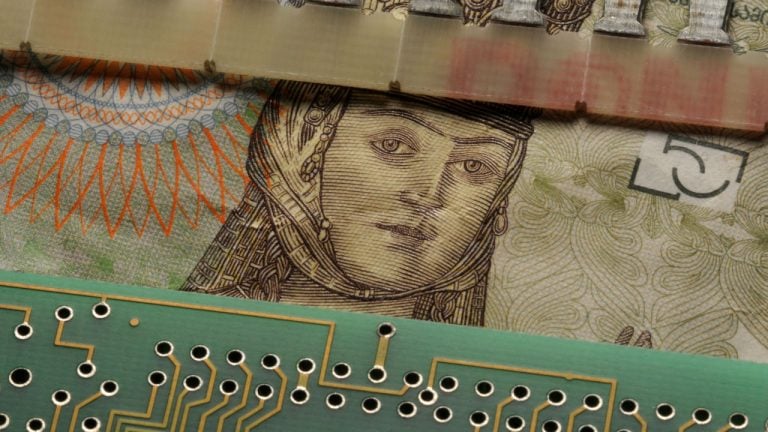 Hamster Kombat, the popular tap-to-earn game built on the TON network, has announced the release of its whitepaper and an updated development roadmap. Through social media, the project revealed that, due to players’ contributions to its success, it has allocated 60% of its upcoming airdrop for community distribution. Hamster Kombat Updates Roadmap, Discloses Community Distribution […]
Hamster Kombat, the popular tap-to-earn game built on the TON network, has announced the release of its whitepaper and an updated development roadmap. Through social media, the project revealed that, due to players’ contributions to its success, it has allocated 60% of its upcoming airdrop for community distribution. Hamster Kombat Updates Roadmap, Discloses Community Distribution […]
25 AI "agents" were given a virtual town and were observed going to a bar for lunch, planning a party and expressing other human-like behavior.
A society of 25 artificial intelligence (AI) bots were observed waking up, cooking breakfast, heading to work, going to the bar for lunch with friends and even throwing a party by six researchers who created a town for the bots.
The researchers from Google and Stanford University explained in an April 7 paper titled “Generative Agents: Interactive Simulacra of Human Behavior” that they built a virtual town populated with ChatGPT-trained “generative agents.”
The purpose of the study — which is yet to be peer-reviewed — was to create a small, interactive society of AI bots inspired by life-simulation games such as The Sims.
The agents could make a wide range of inferences about themselves, other agents and their town of “Smallville” by synthesizing new information, storing it in memory and then behaving in a way that reflects that knowledge.

For example, the agents could turn off their kitchen stove when they see their breakfast is burning, coordinate plans and even engage in seemingly meaningful conversations with other agents.
The results led the researchers to conclude that the generative agents produce “believable” human behaviors:
“By fusing large language models with computational, interactive agents, this work introduces architectural and interaction patterns for enabling believable simulations of human behavior.”
One example shared in the study explained that the AI agent “Isabella Rodriguez” invited nine other agents to a Valentine’s Day party at the town's cafe.
The details of the party were passed on to four others, including “Abigail,” who then expressed excitement about the upcoming event with Isabella.

In another example showing the “day in the life” of an AI agent, “John Lin” woke up at 7 am, brushed his teeth, had a shower, ate breakfast and checked the news at the dining table in his living room.
Before John's son Eddy headed off to school, John asked what he’ll be working on for the day, Eddy responds and John remarks on it before sharing the news with his “wife,” Mei.

However, not everything went right in the experiment.
While the memory of each AI bot would enlarge with each passing interaction, sometimes the most relevant information wouldn’t be retrieved, and as a result "some agents chose less typical locations for their actions."
Related: Elon Musk and tech execs call for pause on AI development
For example, when agents were deciding where to have lunch, many initially chose the town cafe, however, the researchers said:
"As some agents learned about a nearby bar, they opted to go there instead for lunch, even though the bar was intended to be a get-together location for later in the day unless the town had spontaneously developed an afternoon drinking habit."
In another example, some AI agents walked into shops in Smallville that were closed, while some college students walked in on others in the dorm bathroom because they thought it could be occupied by more than one age.
The researchers said they will soon expand on the “expressivity” and “performance” of the AI bots through the more advanced GPT-4, the latest iteration of ChatGPT, which has passed United States high school and law exams in the 90th percentile.
Magazine: NFT Creator, Emily Xie: Creating ‘organic’ generative art from robotic algorithms

Apple’s Mac devices have apparently been hiding Bitcoin’s whitepaper for up to five years.
Satoshi Nakamoto’s original white paper laying out the Bitcoin (BTC) network is seemingly hiding within every modern version of the operating system for Apple’s Mac computers.
An April 5 blog post from technologist Andy Baio revealed that a PDF of the Bitcoin white paper has “apparently shipped with every copy of macOS since Mojave in 2018.”
Baio told Cointelegraph that he was “just trying to fix my printer” and scan a document with a wireless scanner when a device called “Virtual Scanner II” appeared that he’d “never seen before.”
By default, Virtual Scanner II showed a photo, but when Baio changed the media type from "Photo" to "Document," Nakamoto’s white paper appeared.

“I wasn't looking for the Bitcoin paper!” Baio exclaimed. “I was just trying to fix my printer!”
In his post, Baio said there is “virtually nothing about this online.” He shared a November 2020 Twitter thread from designer Joshua Dickens, who also found the whitepaper, which Baio used to find the file location.
Weirdly, there's also a PDF of the original Bitcoin white paper: pic.twitter.com/JjPnI4fyzc
— Josh D (@schwa23) November 28, 2020
Baio created a prompt to use in Terminal, a command line interface for macOS, so others could bring up the whitepaper easily.
“I started asking other Mac-using friends if they could co nfirm it, and all of them could,” he said.
Related: Bitcoin white paper makes its F1 racing debut on Kraken-sponsored car
The prompt successfully opened the Bitcoin white paper on three different Apple Mac devices tested by Cointelegraph.
In his blog post, Baio claimed the file is found on “every version of macOS from Mojave (10.14.0) to the current version (Ventura), but isn’t in High Sierra (10.13) or earlier.”
It’s unknown why Nakamoto’s white paper is shipped with modern versions of macOS. Baio speculated in his post that it was “just a convenient, lightweight multipage PDF for testing purposes, never meant to be seen by end users.”
Cointelegraph contacted Apple for comment but did not immediately receive a response.
Magazine: Bitcoin in Senegal: Why is this African country using BTC?
 Following a growing trend of Ordinal inscriptions on the Bitcoin blockchain, the technology has been ported to the Litecoin network, and the number of onchain Litecoin inscriptions has surpassed 13,000. Software developer Anthony Guerrera made Ordinal inscriptions on the Litecoin network possible by receiving 22 Litecoin to port the technology to the proof-of-work (PoW) blockchain. […]
Following a growing trend of Ordinal inscriptions on the Bitcoin blockchain, the technology has been ported to the Litecoin network, and the number of onchain Litecoin inscriptions has surpassed 13,000. Software developer Anthony Guerrera made Ordinal inscriptions on the Litecoin network possible by receiving 22 Litecoin to port the technology to the proof-of-work (PoW) blockchain. […] The central bank of Georgia intends to publish a document detailing the concept of a national digital currency in the coming months. Other participating parties will use it to finalize their proposals for the pilot which the monetary authority plans to initiate in the first half of the year. Financial Authorities in Georgia Gear Up […]
The central bank of Georgia intends to publish a document detailing the concept of a national digital currency in the coming months. Other participating parties will use it to finalize their proposals for the pilot which the monetary authority plans to initiate in the first half of the year. Financial Authorities in Georgia Gear Up […] The central bank of Kazakhstan has completed the second phase of testing for its digital currency and published a whitepaper. The studies carried out by the regulator on its introduction did not identify significant risks for the country’s financial stability and economy. Monetary Authority of Kazakhstan Reports on Advance of Digital Tenge Pilot Project The […]
The central bank of Kazakhstan has completed the second phase of testing for its digital currency and published a whitepaper. The studies carried out by the regulator on its introduction did not identify significant risks for the country’s financial stability and economy. Monetary Authority of Kazakhstan Reports on Advance of Digital Tenge Pilot Project The […]
The pilot "eAUD" program is unique in that the Reserve Bank of Australia has not proposed use cases, and has received numerous suggestions from the industry.
A Central Bank Digital Currency (CBDC) pilot program in Australia has received more than 140 use case proposals from the finance industry, but the Reserve Bank of Australia (RBA) warns that it could displace the Australian dollar and result in people avoiding commercial banks entirely.
The RBA released a speech on Dec. 8 to be given by Assistant Governor Brad Jones at a central bank conference held from Dec. 8 to Dec. 9 local time, in which Jones speaks at length about what effect a CBDC could have on the Australian economy.
Jones notes that the RBA has been surprised by the industry interest they have received since releasing a white paper on Aug. 9, with over 80 financial entities proposing use-cases covering many areas such as e-commerce, offline, and government payments.
The team working on the pilot “eAUD” program is working out which of the proposed use-cases to take into its pilot phase early next year, and is expecting to publish a report on the project around the middle of 2023.
Jones also discusses the potential risks that are associated with an Australian CBDC, and points to liquidity issues and other issues the banks could face if a CBDC becomes the preferred source of holdings.
For example, with deposits of Australian residents such as savings accounts now making up over 60% of total funding for their banks, enough Australians choosing a CBDC over the Australian dollar could result in banks not having sufficient capital to lend to consumers, which in turn would make it harder for the RBA to transmit monetary policy, he said.

Jones also notes that Australians preferring to hold their funds in a “risk-free'' CBDC could lead to bank runs, with Australians withdrawing deposits en masse.
Related: Report outlines reasons why stakeholders are against CBDC
However, the Assistant Governor suggests CBDCs could also provide Australians with many benefits, such as privacy benefits — arguing that the central bank has no incentive to use personal data which can be exploited by private organizations — and could help safeguard monetary sovereignty that may be lost if a stablecoin or foreign CBDC fills a domestic vacuum.
He also points to the potential for offline transactions to increase the resilience of existing payment systems, in addition to increased efficiency and cost reductions for end-users.
Jones finished the speech by adding that Australians should be confident the Reserve Bank will continue to issue banknotes “for as long as they place value on them as a public good.”
Critics are often concerned that the introduction of CBDCs will end with banknotes being phased out however, a fear which is given credence by Nigeria’s move to further limit cash withdrawals on Dec. 6 following the issuance of the eNaira.

The news comes a couple of weeks after research firm Delphi Labs announced it would shift the focus of its research and development efforts toward the Cosmos ecosystem.
Interoperability-focused blockchain network Cosmos has dropped a new whitepaper proposing a revamped Cosmos Hub aimed at strengthening interoperability and security, along with key changes to its native ATOM token.
The new Cosmos whitepaper was released on Monday at the Cosmoverse conference in Medellin, Colombia. The upgrades outlined in the whitepaper are still technically in “proposal” status but changes are expected to be made on-chain on Oct. 3.
Cosmos is an ecosystem of blockchains designed to scale and interoperate with each other. Cosmos Hub was the first blockchain to be built on Cosmos, which initially served as an intermediary between other interconnected blockchains.
The ATOM token is used to transact within the Cosmos ecosystem, which can also be used for governance and staking purposes.
Under the proposed changes, Cosmos will become a more interoperable, decentralized, and secure ecosystem.
One of the changes outlined is the reinvention of the Cosmos Hub as the “Interchain” web, which will enable other Cosmos blockchains to borrow the Hub’s validator pool to secure its network rather than having to find their own.
Billy Rennekamp, the Cosmos Hub Product Lead added that the value proposition behind this transition to Interchain Security would also make the Cosmos network “legally, defensibly decentralized.”
According to the whitepaper, Interchain Security will also enable Cosmos Hub to “host a novel category of applications with complementary functionality,” stating:
“Interchain Security gives consumer chains a faster, easier, and cheaper path to market [and] the development platform afforded by Interchain Security allows [...] third parties to utilize the Hub’s essential infrastructure to build commercial applications.”
The whitepaper also proposes a new issuance model for the native ATOM token, with the aim to strike a better balance between ecosystem growth and interchain adoption “while still preserving the security afforded by the original regime,” according to the whitepaper.
The new monetary policy will see two phases: “transition” and “steady state.”
The transition phase will see 10,000,000 ATOM issued in the first month, which will then decrease at a declining rate until it reaches the steady state phase 36 months later.
Cosmos co-founder Ethan Buchman said this new token issuance model would enable other Cosmos blockchains to become more interconnected with the Cosmos Hub and ATOM.
Related: Most of the crypto market is down, but Cosmos (ATOM) price is up — Why?
The whitepaper also outlined a plan to further accrue more value to the ATOM token by enabling leveraged liquid staking.
This will allow ATOM holders to unstake ATOM tokens as easily as they staked them, which will soon be enabled by the Cosmos “liquid staking module."
“The user experience and capital efficiency improvement offered by liquid stalking is so substantial” that it required “full economic integration” into the new Cosmos interchain-oriented ecosystem, according to the whitepaper.
Intern notes on Cosmos’ new 27 page whitepaper
— (Delphi, Intern) (@delphiintern) September 26, 2022
TL;DR
- Secure economic scaling ⛓
- $ATOM as reserve currency
- New economic engine
Definitely worth a read!
(1/2) pic.twitter.com/OseBg1kBYp
The release of the whitepaper comes a few weeks after research and investment firm Delphi Labs announced a shift of its R&D efforts to focus on the Cosmos ecosystem.
The research firm outlined network speed, chain liquidity, sufficient decentralization, and cross-chain interoperability as the key factors behind its decision to provide R&D efforts to help further the growth of Cosmos.
 The World Economic Forum (WEF) has released its latest report on “digital currency governance” this month, addressing stablecoins, cryptocurrencies, and “barriers to financial inclusion.” Like most central banks, regulators, think tanks, and politicians, the WEF publication gives lip service to the power of crypto, but never addresses the elephant in the room: instead of actual […]
The World Economic Forum (WEF) has released its latest report on “digital currency governance” this month, addressing stablecoins, cryptocurrencies, and “barriers to financial inclusion.” Like most central banks, regulators, think tanks, and politicians, the WEF publication gives lip service to the power of crypto, but never addresses the elephant in the room: instead of actual […]
Nassim Taleb and Nouriel Roubini criticized tokens in general during a BSV conference panel.
Economist Nouriel Roubini and former risk analyst Nassim Taleb took aim at crypto at the CoinGeek conference this week, while the always controversial Craig Wright boasted that the BSV blockchain was on track to hit billions of transactions a second.
Taleb, the author of best-selling economic books Black Swan and Skin in the Game, was a controversial addition to the lineup of the CoinGeek Conference in Zurich and came under fire on social media for giving BSV legitimacy.
Roubini meanwhile, offered a "greatest hits" version of his of attacks against crypto, familiar from crypto conferences prior to the pandemic.
“There is no reliability, no regulation, no AML, no KYC. [Crypto] is used by terrorists, money launderers, human traffickers, criminals, tax evaders.”
Taleb is gone. Calvin is going to brainwash him even more thoroughly at the Coingeek conference next week. He will be wined and dined and schmoozed and very soon he will be saying "Craig is Satoshi".
— Cøbra (@CobraBitcoin) June 6, 2021
Roubini argued that cryptographic tokens — which includes BSV presumably — are unnecessary and should be isolated from the value of the decentralized data verification enabled by blockchain technology.
“Data is very valuable, it’s the new oil,” he explained, lamenting that “99%” of the fintech application “has nothing to do with cryptocurrencies.” What is needed, Roubini explained, is a service that is “reliable, that stores the data, says who owns it and who pays for it.”
Taleb followed Roubini on the panel, agreeing that the data utilities enabled by cryptocurrency should be understood as a separate phenomenon to the cryptographic tokens issued by many blockchain projects. He shared his belief that those who need crypto and those who can use it are not aligned, adding:
“Who needs cryptos? Well, criminals need cryptos, except it doesn’t work for them.”
Related: Bitcoin’s usefulness is on a whole other level, depending on where you live
The host attempted to get the panel back on track asking Taleb if he agrees that “BTC does not represent what the Bitcoin Whitepaper describes.”
In response, Taleb admitted he thinks Bitcoin in its current form does not resemble the whitepaper, but countered that “the currency in the whitepaper may not be what we are looking for.”
NChain’s chief scientist, Craig Wright, talked up BSV, asserting it was “never designed to be a currency, it’s digital cash” and went on to make the claim:
“We will have a billion transactions a second in a few years, and then we will do one trillion a second.”
As you might expect, those Bitcoiners who did tune in were hate watching the broadcast, including YouTuber “BTC Sessions” who shared that they only “hopped on the stream for a second just to give it a thumbs down.”
Wright’s chief critic Arther van Pelt also tuned in to throw stones and tweeted that the panel was receiving very little viewership, calling it a “clown show.”
Hardly 650 viewers on YouTube when Ian Grigg, Craig #Faketoshi Wright, Nouriel Roubini and Nassim Taleb are on stage. ♂️ pic.twitter.com/dtwD8fE93v
— Arthur van Pelt (@MyLegacyKit) June 10, 2021